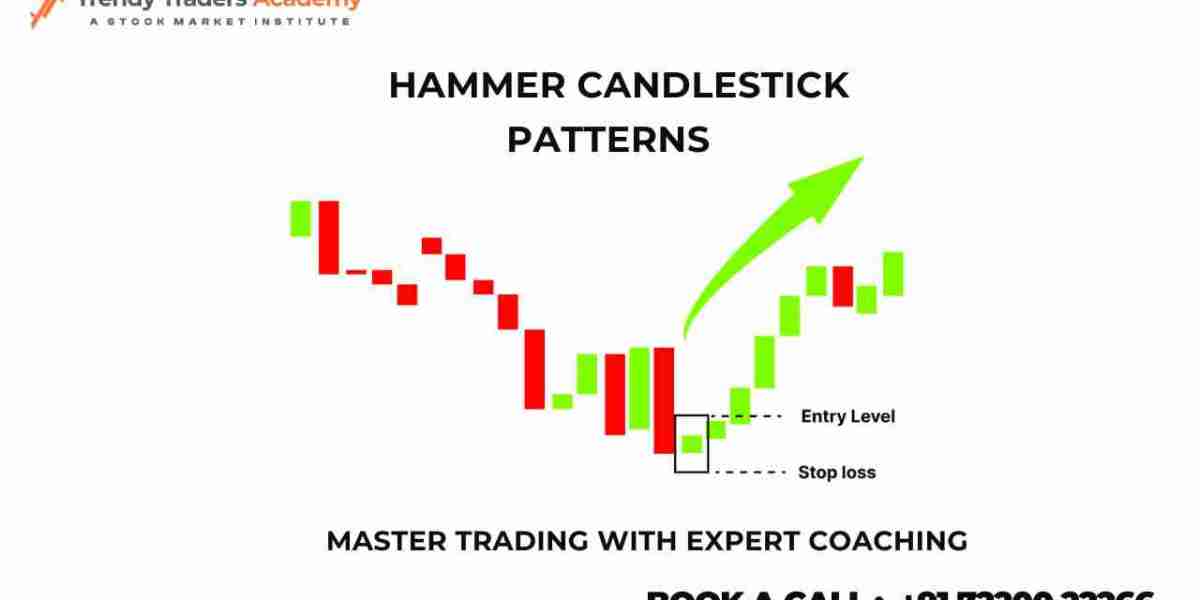Hammer Candlestick Pattern : A Beginner’s Guide to Better Trading Decisions
Understanding the stock market can feel overwhelming, but what if I told you there’s a simple tool that could make your trading decisions a little clearer? The Hammer Candlestick Pattern is a classic example of a signal traders rely on to identify potential market reversals. Whether you're a seasoned trader or just starting your journey with stock market course , this guide will walk you through the essentials of this pattern and how it could fit into your trading strategy.
Let’s break it down, step by step, so by the end, you'll know exactly why it’s worth incorporating into your toolbox.
Learn the Hammer Candlestick Pattern , its importance in stock trading, and why stock market courses and trading classes bangalore are a game-changer.
What is the Hammer Candlestick Pattern?
The Hammer Candlestick Pattern is one of the most recognizable patterns in technical analysis. It appears on a price chart and signals a potential reversal in the market, typically after a downtrend. Think of it like a "stop sign" for falling prices, suggesting that buyers are starting to regain control.
The pattern gets its name because it resembles a hammer, with a short body and a long lower wick, symbolizing the market’s attempt to “hammer out” a bottom.
The History and Origin of Candlestick Patterns
Before diving deeper into the Hammer Candlestick Pattern, it’s fascinating to understand where these patterns come from. Candlestick charting originated in Japan during the 18th century. A Japanese rice trader named Munehisa Homma developed this technique to analyze the price movement of rice. Over time, traders worldwide adapted these methods to forecast stock market trends. The Hammer is one of the many patterns that have stood the test of time, helping traders predict price reversals effectively.
Why is the Hammer Pattern So Popular?
The popularity of the Hammer Candlestick Pattern lies in its simplicity and effectiveness. Unlike complex indicators that require advanced software or calculations, the hammer is easy to spot on any price chart. This accessibility makes it a favorite among traders, from complete beginners to seasoned professionals.
Moreover, its ability to signal a potential reversal in bearish markets adds significant value to trading strategies. Think of it as a flashlight in the dark—helping you navigate uncertain market conditions.
Hammer Candlestick Pattern in Different Market Types
The Hammer Candlestick Pattern isn’t limited to stocks. It can be applied across various markets, including:
- Forex Trading: Spot currency pair reversals, such as USD/EUR, using hammer patterns.
- Cryptocurrency: Volatile markets like Bitcoin often produce hammer patterns, providing entry points.
- Commodities: Gold, silver, and crude oil charts frequently display this pattern.
By understanding the nuances of different markets, traders can fine-tune their strategies.
Hammer Candlestick in Day Trading vs. Swing Trading
Traders use the Hammer Candlestick Pattern differently based on their trading style:
- Day Trading: In intraday trading, hammers often form on smaller timeframes like 5-minute or 15-minute charts. Quick decision-making is crucial here.
- Swing Trading: For swing traders, the hammer is more reliable on daily or weekly charts, offering a broader perspective on trend reversals.
Both methods work well, but they require distinct approaches to risk management and timing.
How to Backtest Hammer Patterns Effectively
Backtesting is the process of testing a trading strategy on historical data. To backtest the Hammer Candlestick Pattern:
- Gather Historical Data: Use charting software to collect past price data.
- Identify Hammers: Manually or through automated tools, spot hammer patterns.
- Measure Success Rates: Check how often the pattern correctly predicts reversals.
- Refine the Strategy: Adjust entry and exit rules based on your findings.
For example, you might find that hammers combined with RSI signals perform better than hammers alone.
The Role of Risk Management
No trading pattern, including the hammer, guarantees success. Proper risk management ensures you stay in the game even when trades don’t go as planned. Here are a few tips:
- Set Stop-Loss Orders: Place stop-losses below the lower wick of the hammer to minimize potential losses.
- Avoid Overleveraging: Don’t risk more than 1-2% of your trading capital on a single trade.
- Diversify: Spread your investments across different stocks or asset classes.
By managing risks, you protect yourself from the inherent uncertainties of trading.
Case Study: Real-World Application of the Hammer Pattern
Let’s consider a real-world example.
Stock: Tesla Inc. (TSLA)
In 2023, Tesla’s stock faced a significant downtrend due to market concerns over production delays. During one of the trading sessions, a hammer candlestick formed, signaling a potential reversal.
- Confirmation: The following day, Tesla’s stock opened higher and continued to rise, confirming the hammer’s signal.
- Outcome: Traders who acted on the pattern captured a 15% upward swing in the following weeks.
This case highlights how the hammer can provide actionable insights when used correctly.
How to Build Confidence in Using the Hammer Pattern
Trading confidence doesn’t come overnight. Here are actionable steps to improve:
- Paper Trading: Practice spotting and trading hammer patterns using virtual money before committing real funds.
- Join Stock Market Courses: Structured learning, especially in places like Bangalore, can provide expert guidance.
- Review Trades: Maintain a trading journal to analyze what worked and what didn’t.
Confidence grows as you gain experience and refine your approach.
Hammer Patterns and Market Sentiment
The Hammer Candlestick Pattern reflects market sentiment at its core. It shows that sellers initially dominated, but buyers fought back strongly, closing near the day’s high. This shift in sentiment often foreshadows further buying pressure.
For instance, in a bearish market where fear dominates, a hammer signals the return of optimism, giving traders a psychological edge.
Tips for Identifying False Signals
Not every hammer candlestick results in a reversal. Here’s how to avoid being misled:
- Check the Volume: Low volume hammers may not indicate a strong reversal.
- Look at the Trend Strength: Weak downtrends may produce unreliable hammer patterns.
- Wait for Confirmation: Avoid acting solely on the hammer; wait for the next candlestick to validate the reversal.
The Future of Candlestick Analysis in AI-Driven Trading
With advancements in AI and machine learning, tools are now available to automatically detect patterns like the hammer. However, human intuition remains invaluable. Even with AI assistance, understanding the Hammer Candlestick Pattern allows traders to make informed decisions, blending technology with personal expertise.
Expanding Your Knowledge with Expert-Led Coaching
Platforms like Trendy Traders Academy and other institutes in Bangalore provide in-depth training on candlestick patterns and trading strategies. Under expert mentorship, you'll learn not just about patterns but also the psychology of trading, risk management, and market dynamics.
Investing in your education is the first step toward trading success.
Anatomy of a Hammer: How to Identify It
To spot a Hammer Candlestick Pattern, look for these key features:
- Small Body: Located at the top of the candlestick.
- Long Lower Wick: At least twice the size of the body.
- Little to No Upper Wick: Shows minimal price movement above the opening price.
- Appearance After a Downtrend: Essential for its validity as a reversal signal.
Here’s a simple analogy: Imagine the hammer as a nail being driven into the ground (the lower wick), with the small body representing the handle. This visual makes it easy to remember!
The Psychology Behind the Pattern
Why does the Hammer Candlestick Pattern work? It all comes down to market psychology. When prices drop, sellers dominate. But when a hammer forms, it means buyers are fighting back, pushing prices upward before the close. This tug-of-war indicates a potential reversal is on the horizon.
Types of Hammer Candlestick Patterns
There are two primary types of Hammer Candlestick Patterns:
- Bullish Hammer: Appears after a downtrend and signals a potential upward reversal.
- Inverted Hammer: Similar to the standard hammer but with the long wick above the body, indicating possible bullish momentum.
Hammer vs. Hanging Man: Don’t Get Confused!
While the Hammer Candlestick Pattern signals a bullish reversal, the Hanging Man looks similar but appears at the top of an uptrend, indicating a potential bearish reversal. Always check the context of the trend to avoid mixing the two!
Real-Life Examples in Trading
Imagine you’re trading a stock that has been declining for weeks. Suddenly, you notice a hammer candlestick forming. This could be your signal to watch for a trend reversal and consider entering a long position. Real-life examples abound, particularly in volatile stocks or commodities.
How to Use the Hammer Pattern in Your Trading Strategy
Here’s a step-by-step guide:
- Identify the Downtrend: Confirm the market is in a bearish phase.
- Spot the Hammer: Look for the characteristic shape.
- Confirm with Volume: A hammer with high trading volume strengthens its reliability.
- Set Entry and Exit Points: Use stop-loss orders to minimize risk.
Combining Hammer Patterns with Technical Indicators
To improve accuracy, combine the Hammer Candlestick Pattern with:
- Moving Averages: To confirm trend reversals.
- RSI (Relative Strength Index): To identify overbought or oversold conditions.
- Support and Resistance Levels: For additional confirmation.
Common Mistakes to Avoid
- Ignoring the Context: Always analyze the broader trend.
- Overtrading: Not every hammer is worth acting on.
- Skipping Confirmation: Wait for additional signals before entering a trade.
Importance of Learning Through Stock Market Coaching
Trading isn’t just about spotting patterns—it’s about understanding their context. Enrolling in stock market coaching helps you learn the nuances of patterns like the hammer and how to apply them effectively.
Stock Market Courses in Bangalore: Elevate Your Trading Game
Bangalore, known for its thriving financial community, offers excellent stock market courses. These programs provide hands-on training and insights tailored to both beginners and advanced traders.
Trading Training in Bangalore: Why It’s the Best Choice
Why Bangalore? The city boasts top-notch institutes with experienced mentors who simplify concepts like the Hammer Candlestick Pattern, helping you trade with confidence.
Can Beginners Use the Hammer Candlestick Pattern?
Absolutely! The hammer is beginner-friendly and easy to recognize. Pair it with guidance from a good stock market courses to build a strong foundation.
Advanced Tips for Experienced Traders
- Use the hammer in conjunction with Fibonacci retracements.
- Look for hammers on higher time frames for more reliable signals.
- Monitor multiple assets to spot the best opportunities.
Conclusion: Empowering Your Trading Journey
The Hammer Candlestick Pattern is a timeless tool for identifying potential market reversals. Whether you’re trading stocks, forex, or cryptocurrencies, this pattern offers actionable insights when used correctly. Pairing it with technical indicators, risk management, and expert coaching can significantly enhance your trading success.
Now that you’re equipped with this knowledge, why not take the next step? Enroll in stock market coaching or trading training in Bangalore to deepen your understanding and become a more confident trader.
FAQs
- What is the Hammer Candlestick Pattern?
The Hammer Candlestick Pattern is a bullish reversal signal that appears after a downtrend, characterized by a small body and a long lower wick. - How can I confirm the validity of a hammer pattern?
Look for high trading volume, combine it with technical indicators like RSI, and ensure it appears in the context of a downtrend. - Can beginners effectively use the hammer pattern?
Yes! It's simple to recognize and ideal for new traders when paired with proper coaching. - Is the Hammer Pattern reliable on its own?
While useful, it’s best combined with other indicators or patterns for higher accuracy. - Why should I take trading training in Bangalore?
Bangalore offers top-tier stock market coaching, combining theory and practical application for a comprehensive learning experience.



